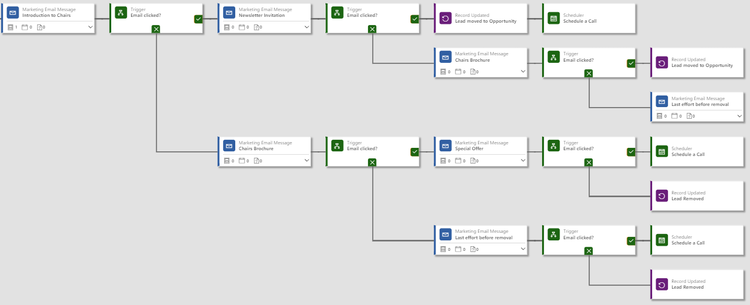Modern lead management with Dynamics 365 for Marketing
Dynamics 365 for Marketing contains many more capabilities in its entirety, this blog highlights the lead Management portion of the app. For a more complete overview of Dynamics 365 for Marketing and its features, check out our other blog post.
It’s about the customer, not you
Attracting, capturing, and closing on high-quality leads has become an art form in today’s ultra-competitive digital age. What used to be a combination of cold-calling, print ads, and a bit of luck has shifted to social media, personalized messages, drip campaigns, and an overall focus that’s more on the customer, not your company. Companies must adopt at least some form of most of these practices in order to stay competitive in today’s environment, but that’s a lot easier for large corporations than small and midsize companies. This is where Microsoft’s Dynamics 365 for Marketing comes into play.
Many businesses cannot afford the huge price tag that comes with a marketing solution like Hubspot, Marketo, or many others promising enterprise level marketing automation. Even if they can afford it, they’re likely paying for a long list of features that are above what they need to do and are thus wasting money. Dynamics for Marketing is special in that it’s built to fit what you do, not the other way around.
Customer journeys
You’ve likely heard of and/or looked into using drip campaigns in some of your marketing initiatives. Drip campaigns give you a set visual direction of where you’ll be taking your leads, step-by-step, based on how they react to your marketing efforts. As you move, or ‘drip’, them down this path, you’ll gather more and more info about your leads and will be able to more accurately estimate the probability of a sale.
One of the main functions of Dynamics 365 for Marketing is something very similar, known as Customer Journeys, that gives you the same powerful insights.
Customer Journeys essentially lay out which forks in the road a lead will take on their way to becoming or not becoming a customer. In the screenshot below, you can see there are a number of ways a lead can move through the nurturing process, and this is just a basic email marketing example.
As leads receive your messages, they may or may not open it, may or may not click on a link within the email, may subscribe to your newsletter, or may ask to be removed from your mailing list. All these choices will send leads on a different journey towards making or not making a purchase.
The drag-and-drop design tool makes every step of a journey visible so you’ll always know the next steps in the process.
Scoring & ranking your leads
Now that you have journeys in place for incoming leads, it’s time to assign point values for each of the actions they do or do not complete along the way. It’s important to understand that leads can be at different stages of the buying process depending on where they come in from, so scoring or ranking them is essential to know which ones are priority and what types of info they’re looking for.
There are leads who have just heard of your product for the first time and hardly, if at all, understand what it is or how it will benefit them. There are also leads who are in the deep stages of the buying process and have already researched substitute products, your business/product, and its competitors. Dynamics 365 for Marketing helps you understand and rank these leads so you can estimate the likeliness of obtaining a sale. When making first contact with a lead, it’s hard to gauge how seriously interested they are, but, after the initial contact, you’re able to score and rank leads based on their interactions and behavior towards your marketing initiatives. Below is a simple email scoring model containing conditions, actions, and the point value associated with the action being taken.
The point value, grading systems, and sales-ready scores are completely customizable. There are many entities already built into the system for things related to emails, events, form submissions, and more, as well as the ability to create custom channel activities. Once a lead reaches the sales-ready threshold you have in place, they’ll be automatically updated from a Lead to an Opportunity.
Improving the process
Once you have some leads who have successfully gone through a customer journey process all the way to making a purchase, it’s important (and pretty easy) to gather feedback from these new customers. Voice of the Customer (VOC) is a survey creation/design tool that comes included in Dynamics 365 for Marketing and allows for near-complete customization, with the option to write custom CSS code and make your surveys look exactly how you envision. There are currently 19 different elements you can place on your surveys, so you’ll certainly be able to gather all the info you’re looking for.
Surveys are easily delivered via email to the contacts you choose, or you can set up anonymous responses for purposes such as social media. Add surveys to customer journeys to gather feedback along the way. They can also be personalized to each recipient so customers don’t realize they’re getting a mass email.
Using responsive routing, surveys can be intelligent and prompt other questions based on responses. On top of all that, VOC includes a results dashboard that compiles responses and puts them into visual, actionable insights for your business.
Want a Dynamics 365 for Marketing demo?
Dynamics 365 for Marketing is more than just email automation, it will help you control many different avenues of your marketing initiatives. If interested in Dynamics 365 for Marketing, fill out the form below to speak with one of our consultants who can provide you a quote estimate, get you a free Dynamics 365 trial, and work with you to customize your deployment.






